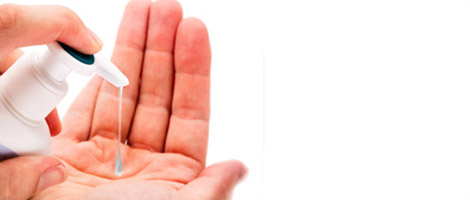
Lubricants
Commonly referred to as ‘lube’, personal lubricant is a substance that decreases friction between moving and rubbing surfaces; where there is an absence of natural wetness, the addition of lubricant will help objects to slide better. It is therefore commonly used to facilitate masturbation, vaginal and anal intercourse, and the use of sex toys.
Many people consider personal lubricant an indispensable aid to better sex; yet there are plenty more who haven’t yet discovered the delight that comes from a bottle of the slippery stuff. This comprehensive lubricant guide will explore the many benefits and help you wade through the quagmire of options to choose from. We’ll also fill you in on additives to be wary of.
Why is lubricant important?
Moisture is an essential element of sex; without it, you’ll quickly experience dryness, chafing, and infections like Urinary Tract Infections, none of which are conducive to pleasure! Personal lubricant facilitates extended sex sessions that can involve acts that go far beyond vaginal intercourse. It also eases the use of sex toys and assists with certain sexual positions.
Since the anus and rectum are not self-lubricating, lube is of the utmost necessity when it comes to anal play. It also goes hand-in-hand (get it?) with masturbation. Spur of the moment sex can be thrilling for both men and women, but it also requires some ‘instant’ wetness to help go the distance.
Another great use for lube is to increases sensitivity while wearing a condom. To do this, add a drop or two of water-based lube onto the head of the penis before putting the condom on. However, be sparing as if you add too much, you run the risk of the condom slipping off. Feel free to add a few drops to the outside of the condom. Also, using lubricant can also help prevent premature ejaculation.
Adequate lubrication is vital to physical enjoyment, but some women feel embarrassed using it with a partner for fear of it negatively reflecting on their natural ability to get wet. In other words, they don’t want their partners to take their vaginal dryness as an indication that they’re not turned on enough. However, women shouldn’t be embarrassed by the necessity or desire to use lube. There are plenty of perfectly normal factors that can cause or contribute to vaginal dryness…
Medical conditions, particularly diabetes and cancer, can significantly decrease vaginal moisture. Physical and emotional stress will also do it. Drugs such as hormone replacement therapy, antibiotics, anti depressants, antihistamines and some decongestants can also dry out mucous membranes in the vagina. Diet and lifestyle choices such as cigarettes, alcohol, a salty diet, and coffee are also factors. Interestingly, the existence of breast implants can also have a drying effect.
Declining estrogen levels, which generally begins in a woman’s late thirties, will contribute to vaginal dryness. This can also occur during pre and post menopausal stages. If women experience a lack of moisture at a younger age, it could be due to a natural dip in their menstrual cycle or as a side effect from taking oral contraceptives. Prolactin, a hormone responsible for breast-feeding, can have an anti estrogen thus making it another hormone related factor in decreased vaginal secretions.
The Guide
Natural vaginal secretions and saliva will only go far; once they evaporate, you need to rely upon other forms of lubrication to improve sexual activity. If you’ve ever thought that choosing a sex toy was confusing, you won’t be off the hook when it comes to selecting a personal lubricant. They come in a variety of formulations and serve a multitude of purposes. Let us help you pick the right one...
1. Water-Based Lubricants
These are universal and the most widely available form of lubricant. Once they dry out, adding a little water will rehydrate them. They are produced with and without glycerine.
Pros - they’re condom friendly, easily flavored, and have a smooth, thin consistency. They can be used with any sex toy, make for an easy clean up, and are very condom compatible. Water-based is best for oral sex. Overall, water-based formulations are THE all purpose lube.
Cons - these aren’t very useful in the bath or the shower as they wash off the body easily and may leave a sticky residue due to their additives; however, modern versions are formulated so as not to leave a tacky trail. They’re absorbed by the skin, evaporate quickly, and generally require reapplication.
2. Silicone-Based Lubricants
A little goes a long way. It’s a little more expensive but is designed for the intimate encounters that last for a while. If you’re trying to set a personal best, silicone’s the way to go.
Pros - generally, they’re odor-free and hypoallergenic. These don’t get absorbed into the skin and instead, remain on the skin’s surface, providing a longer lasting slickness. Silicone is body friendly and it doesn’t affect the body’s pH balance like water-based might; unfortunately, you’ll need a bit more effort to wash it off. They are bath, shower and hot-tub friendly. (Cannonbaaaall!) Silicone makes for great massage oil because it is water resistant.
Cons - silicone lube cannot be used with silicone sex toys because it will degrade the toy’s surface. Be sure to check the labels because they’re not all certified as condom and latex safe. It’s not the best choice for oral sex and often costs more. Silicone can be difficult to wash off, especially the longer it stays on the body.
3. Flavored Lubricants
Aside from creating slippery surfaces, flavored lubricants add a playful element to your sex life by providing refreshing scents and pleasing flavors.
Pros - they generally come in non-staining, water-based formulations that can be cleaned up with a bit of soap and water. They are compatible with latex products and can be used for oral and genital sex. Although touch and sight are customary senses for sex, flavored lubes are a great way to integrate smell and taste into the play.
Cons - flavored lubes are tasty but the downside is that they often contain ingredients that are irritating to the pH balance in the vagina. Excessive sugar is the biggest culprit and contributes to unpleasant vaginal conditions like yeast infections. If this is a concern, avoid using it internally or choose a variety that’s sugar free.
4. Natural/Organic Lubricants
The market is embracing these body-friendly, chemical-free versions of mainstream lubes. They’re usually water-based.
Pros - they’re not tested on animals, contain no petro-chemicals, and are a welcome relief to those with sensitive systems. These generally contain organic ingredients and natural preservatives, that come along with additional health benefits e.g. naturally antibacterial/antifungal.
Cons - they may cost more.
5. Oil-Based Lubricants
These are not recommended as a safe sex lube and are best for external use like massage or male masturbation.
Pros - oil based lubes usually contain natural ingredients like organic oils or skin softeners that can taste and smell delicious. They often moisturize and condition skin.
Cons - they cannot be used with products that contain latex, such as condoms, dams, gloves, and diaphragms without rendering them useless. The oil can leave a coating that leaves tissue vulnerable to bacteria and worse, infection. Also, they have the capacity to stain fabrics.
6. Warming and Cooling Lubricants
These become warm or cool on contact with the skin; alternatively, they change in temperature when you blow on them or rub them in. These do reach a maximum temperature so you don’t have to worry about them burning you. With that said, do a patch test before you put them on more sensitive areas such as nipples, inner thighs, penis, or the clitoral hood.
Pros - these add a unique aspect of fun to sex as they enhance sexual sensitivity and heighten sensation in women.
Cons - the sensation may be distracting or uncomfortable. It may also get too hot once you start rubbing.
7. Anal Sex Lubricants
Companies often market lube that is specifically formulated for anal sex - they’re usually water-based or silicone.
Pros - there is a lot of variety to choose from and designed for long-lasting effects.
Cons - if your anal lube is silicone based, you can’t use it with your silicone toys, which is a common material used to make anal toys.
8. Arousal Lubricants
Also referred to as “tinglers”, these contain herbal stimulants or vasodilators that increase blood flow to the area where it is applied.
Pro - when these are applied to sensitive areas of the body, such as the g-spot, penis, or clitoris, they can temporarily engorge the area with blood. This makes them easier to stimulate and adds more intensity to the sensation.
Con - effects can last for up to an hour, so be prepared to endure the feeling. Some may find the tingling sensation uncomfortable.
9. Prolonging Lubricants
These make you go longer and stronger by reducing the sensitivity of the penis. They come in cream, gel or spray form – apply them and allow it to be absorbed into the skin before proceeding to penetration. They may contain chemicals that end in ‘–caine’ such as novocaine.
Pros - they delay climax and help prevent male premature ejaculation. Generally, they’re water soluble and condom safe.
Cons - they have a tendency to numb the receiving partner, which is why it’s a good idea to use a condom with them. Prolonging lubes can only be applied a limited number times in a 24 hour period before giving you irritation, pain, or a rash. Do a patch test and don’t use them on sensitive or broken skin!
10. Vaginal Moisturizers
This type of estrogen-free, female lubrication comes in the form of beads or globules. Their “wettening” effect can last for days.
Pros - they restore vaginal moisture, which is naturally lost due to menopause and aging. These give women enhanced comfort as well as the freedom to act spontaneously.
Cons - they may alleviate symptoms of dryness but won’t address any underlying conditions. Make sure you discuss severe or ongoing vaginal dryness with a doctor.
Additives
There are plenty of additives found in lube that were originally intended for industrial, not personal, use! Even though these chemicals are found in small amounts, people can still have reactions to their toxicity because they’re being applied to extremely absorptive tissue. Common components such as sugar or petroleum can also create detrimental effects to the body. Here is a non-exhaustive list of additives and ingredients in personal lubricant to be aware of:
- Glycerine is commonly found in soap and can make things slippery. It does contain sugar, which makes it taste sweet, but can exacerbate vaginal yeast infections in those persons who are prone to them. Fortunately, there are many glycerine free options.
- Petroleum, most popularized by petroleum jelly, is usually sold as a protectant in skin care products. You can find it as an ingredient in personal lubricant because it’s slippery and hypoallergenic. It does not absorb into skin (because it repels moisture) and can leave a greasy topcoat. It also doesn’t clean up well. The biggest issue with this is that it weakens the structure of latex, making it vulnerable to rupture.
- Oil based lubricants such as mineral oil, baby oil, or body lotion can also break down the latex in a condom and create a vaginal environment that’s ripe for infection.
- Sugar, a common ingredient in flavored lubes, can create an imbalance in the natural pH of a woman’s vagina. Sugar can contribute to yeast infections by acting as a food source for the yeast.
- L-arginine, an amino fatty acid that enhances the action of nitric oxide, has been used to treat sexual dysfunction in women as well as erectile dysfunction in men. It is touted as enhancing sensation and increasing arousal by improving blood flow to the genitals. There are risks such as increasing the chance of a Herpes outbreak in individuals with herpes. Discuss this sexual enhancement supplement with your doctor.
- Parabens, such as Methylparabens and Propylparabens, are examples of petro-chemicals. Not only are they linked to skin irritation, they’re also suspected of disrupting hormone functioning.
- Propylene glycol, another petro-chemical, can be harmful if inhaled, ingested, or contacted with the skin. One of its many uses is as a solvent in paint.
- PEG or Polyethylene Glycol, produces the opposite effect of lubrication by drying out skin.
- In addition to these ingredients, be very careful whenever you use products that contain dyes or fragrances. In addition to the risk of allergic reaction, these specific additives can also degrade the compounds that sex toys are made of.
Final Tips
Apply personal lubricant onto any parts that get inserted, such as fingers, toys, or the penis. As well, use it on areas of the body that receive rubbing, like the female genitals or the anus.
Apply generously - but don’t over-lube. As important as it is to use enough of it, you don't want to go overboard and risk decreasing sexual sensation. Look for lubes that come in easy to apply containers that have snap tops or pumps.
Before you buy a giant bottle, ask if there are trial sizes available. One or two-use samples are very quite common. They’re a great way to try a tingler or a particular flavor of lube.
Never be embarrassed about bringing personal lubricant into play. It ought to be as natural to have around as condoms!
To shop for Lubricants, please click here.


